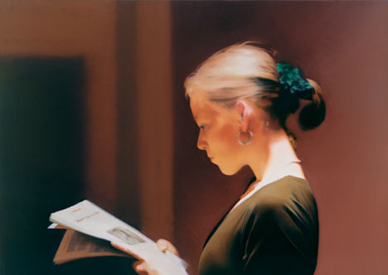| |
| A Photograph that has never ceased to inspire ... |
| A photograph that has never ceased to inspire me is Morning Cleaning by Jeff Wall. In it, the late afternoon light shines into an interior space that can be promptly identified as Mies van der Rohe’s renowned Barcelona Pavilion. In the shadow is a custodian bending over his equipment about to clean the vast windows that separate him from a nude sculpture on the outside patio. I cannot think of another work by Jeff Wall that seems as incidental as Morning Cleaning. |
 Spot Toning, Marco Bohr 2003 |
|
| The constructed environment in modern architecture was always a pet subject in the earlier history of photography. The pragmatic reason for that was the static nature and availability of daylight on buildings such as Wright’s Prairie Houses, Gropius’ Bauhaus or Le Corbusier’s Chapel. However, the personal attraction for Morning Cleaning was of a different sort. The custodian at work in such aesthetically prestigious environment, created an ambiguity often seen in Wall’s photographs. The banality of his presence is questionable: maintenance of beauty, obliviousness to beauty or the (planned) accidentalness of Wall’s very own understanding of beauty. |
 Morning Cleaning, Cibachrome in Lightbox Jeff Wall, 1999 |
|
| Always trying to incorporate other artists work in my own visual practice, I couldn’t help but think of ‘Wall’s custodian’ on a recent shoot in the boardroom of Canada’s largest bank. I was warned that a group of carpenters is maintaining the floor and that I shouldn’t be shy to send them away when they enter the photograph. The opposite was the case when I realized that these men were spot-toning the wooden walls with minute brushes and a pallet of varnish. |
| The dualism I hoped to have captured is that of a laborer amidst a stronghold of corporatism that splurges on architecture, design and art. The brush stroking carpenter observing his ‘piece’ amongst paintings acquired by the bank is another duality that is more reflective of the medium itself. Photography and painting as matter of forms have lived side by side for more than 150 years. However, the coexisting history of photography and painting as forms of art is much more recent, yet vaguely intersecting. |
 Lesende, Oil on Canvas Gerhard Richter, 1994 |
|
| The parallelism of photography and painting has rarely been more explored than in the work of Gerhard Richter. Often using photographs as the basis of his paintings, so that the properties of painting and photography can seem completely jumbled together, Richter, it is thought, creates a universe with seemingly no solid ground anywhere. Especially, his ‘out-of-focus’ paintings based on everyday snapshots are hard to categorize and lead unwillingly to the question: “How did he do that?” |
 Nude, C-Print Thomas Ruff, 2000 |
|
| Similar to Richter, one questions the means of production and its conceptual connotations in Thomas Ruff’s latest series depicting men and women engaged in sexual acts on large scale photographic prints. The work originates from porn sites on the internet as one could guess and by “blurring and distorting his sources, Ruff has seemingly sprinkled the magic dust of painting into his art. [..] Technology and medium make Ruff’s work different, but the imagery is unmistakable, and the out-of-focus sexuality stands directly in Richter’s shadow” as Jerry Saltz writes for the Village Voice. |
| Do new implications in technology and new generations of genre-neglecting artists imply a complete intertextuality between painting, photography and digital art in our post-postmodernist era? Either way, with the reversed history of photographic grain turning into brush strokes and then morphing into pointillist pixels in the random example above, I cannot help but wonder what there is to come. |
| Marco Bohr, 2003 |
back to essays |
 |
| |
| |



